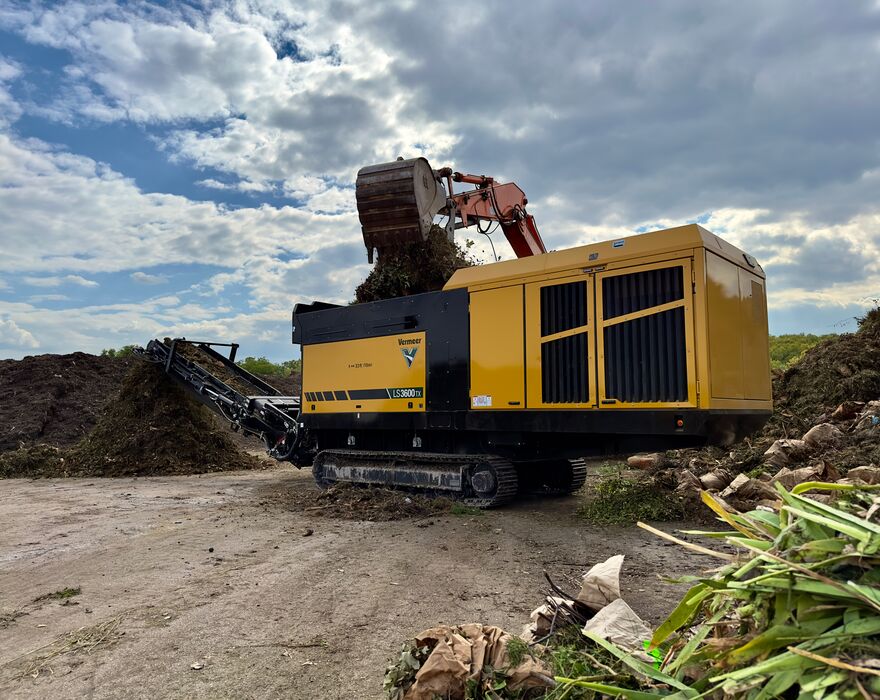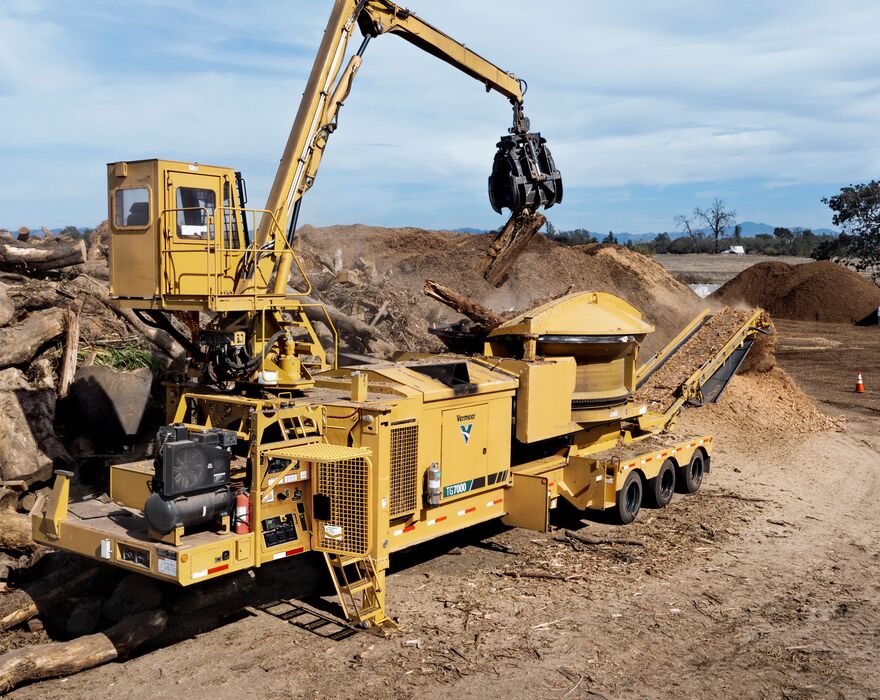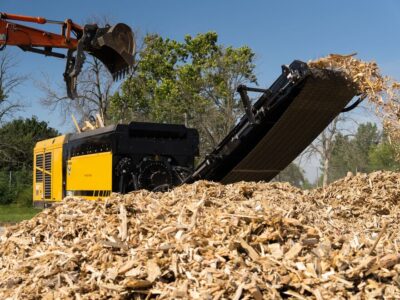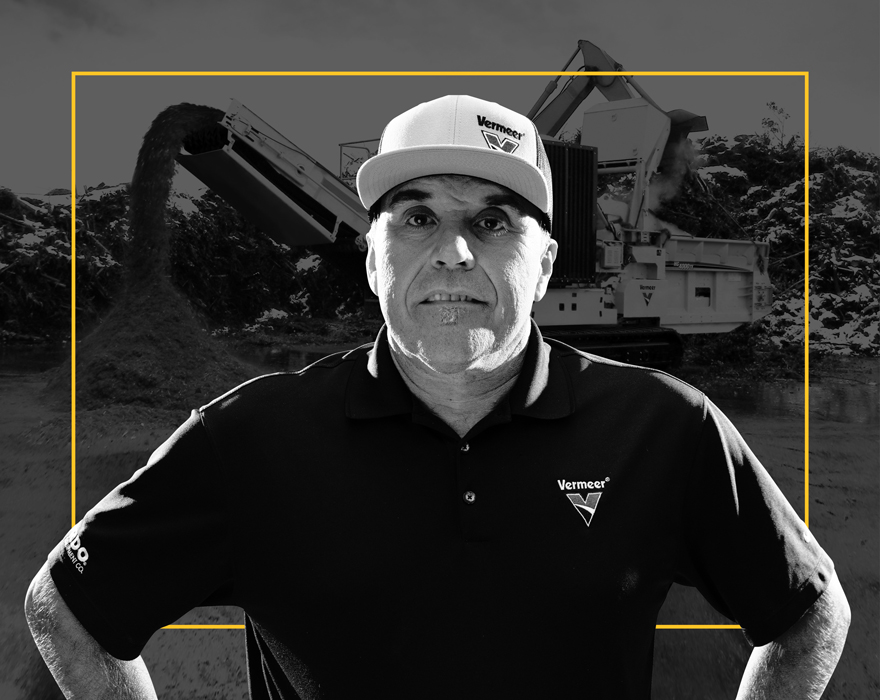For many waste processing facilities around the globe, sizing and recycling incoming waste streams is a necessary practice.
Facility managers need to determine the best processing equipment for their fleet to effectively handle different waste streams. The two most common equipment types for sizing wood waste, construction and demolition (C&D) material, and municipal solid waste (MSW) are low speed shredders and high speed grinders.
Understanding the difference between shredders and high speed grinders is important for waste facilities. Knowing which materials work best with each machine can help waste facilities process waste more efficiently, enabling effective waste management.
Waste sizing equipment categories
Recycling and forestry professionals use low speed shredders and high speed grinders to process a variety of waste materials. When evaluating high speed grinders, there are two machine styles: horizontal grinders and tub grinders. The categorization of low speed shredders typically depend on the number of shafts, which can range from one to four.
Several factors, such as the type, size and shape of the material to be processed, the location of the facility, and the desired end product, influence the choice between these machines.
Jeff Bradley, Recycling and Forestry product manager explained, “Shredders are an excellent choice for recycling operations that encounter materials that may contain contaminants like metal objects. Tub and horizontal grinders are often used to process clean organic wood waste efficiently and reduce materials to a more consistent size, compared to most shredders.”
When and where to use a low speed shredder
Low speed shredders are versatile machines that excel in processing material with contaminates due to their low rotor speed and high torque configuration. Shredders can handle a wide range of waste streams including C&D waste, contaminated green waste, MSW, storm debris and materials from land clearing operations where crews may encounter more than just organic material. Operators often use these machines for primary size reduction because they are less likely to damage components when encountering ferrous contaminants.
Shredders are also highly effective at processing materials such as railroad ties and heavy C&D waste. While processing material, shredders can remove ferrous metals when equipped with crossband magnets, which allow companies to process a wider range of materials and potentially create new revenue streams. Operators can utilize a horizontal grinder or tub grinder for final product sizing needs once any metal contaminants are separated from the organic material.
In addition to tackling contaminated material, shredders can process certain types of synthetic materials mixed with other waste streams more efficiently than high speed grinders.
For smaller waste facilities or those in urban areas, shredders are a good option for primary size reduction of material. These heavy-duty machines are fuel efficient, operate quietly, help minimize dust and because of their low speed, are less likely to throw objects long distances.
Shredder limitations
The slow rotor rotation speed is one of the qualities that make shredders more tolerant of contaminants. However, those slow speeds also mean shredders take longer to process material than high speed grinders. For product sizing, slow speed shredders produce chunky, inconsistent product sizes that may require additional processing depending on the intended use of the material.
When evaluating if a shredder would be the right fit for your fleet, consider maintenance accessibility. Many shredders have limited access to the engine compartment, rotor and comb. Newer models — like the Vermeer LS3600TX low speed shredder — are designed to help owners and operators service equipment safely, efficiently and with ease.
The LS3600TX features unparalleled access to key machine components, including large doors to the engine bay, multiple ladder points and a spacious service platform. This design allows clear access to the rotor and comb. Additionally, this shredder is equipped with a reversible mechanical transmission for efficient power transfer and a torque limiter that automatically disengages the driveline when maximum torque is experienced, helping to protect critical machine components.

When and where to use a high speed grinder
High speed grinders — such as tub and horizontal grinders — deliver speed and productivity by design. They use fast-spinning hammer mills, from 800 rpm to 1,300 rpm, for quicker material processing compared to low speed shredders. This makes them suitable for facilities with non-contaminated materials and when throughput is prioritized. High speed grinders deliver consistent material sizing with adjustable cutter tips and screen sizes, providing operators with control over the final product’s size.
Grinders are excellent tools for transforming organic waste such as trees, plants and yard materials, into valuable end products like compost, mulch and biofuel. The finished size after grinding varies depending on the market application:
Compost — Under 4 in (10.2 cm) in length and width
Mulch — 1.5 in to 2.5 in (3.8 cm to 6.4 cm)
Biomass/biofuel — Size varies depending on the power plant burner type and conveying system
Changing screens on a grinder allows you to produce varying material sizes according to your needs, providing a level of control that isn’t obtainable with shredders. This flexibility enables operators to meet the specific size requirements of different markets, which can help the versatility of waste processing operations.
Choosing between a horizontal grinder and tub grinder
When deciding between a horizontal and tub grinder, understanding the unique advantages of each can help in making a choice tailored to your facility’s needs.
Ted Dirkx, Recycling and Forestry sales manager said, “Horizontal grinders are ideal for tackling longer material. If your waste stream includes a large volume of long-cut tree branches and limbs, a horizontal grinder can reduce the cutting time before processing the material. This efficiency can lead to considerable time savings in waste processing operations. Another application where horizontal grinders excel is handling loose green waste, making them a versatile option for multiple waste streams.”
On the other hand, tub grinders can handle bulkier materials such as tree stumps and processed wood materials like pallets. Unlike horizontal grinders that utilize conveyor chains, tub grinders rely on gravity to feed the hammer mill. This design results in fewer moving components to service.
Tub grinders are also efficient at processing loose green materials. This flexibility makes them a valuable asset for facilities dealing with various waste types.

Grinder limitations
Due to their high rotational speed, grinders are more prone to component damage when exposed to contaminants. They also produce more noise and require a larger thrown object zone compared to low speed shredders. Therefore, these grinders require more operating space.
When to use high speed grinders and low speed shredders together
You may want to consider using high speed grinders and low speed shredders in conjunction. By utilizing a low speed shredder to pre-shred material, facilities can remove contaminants and improve the overall efficiency of their operations.
This combined approach is especially useful in waste facilities that allow public dumping, as these locations often have higher contamination rates. By employing a low speed shredder at the primary shredding stage, facilities can remove contaminants before sending the material to high speed grinders for final sizing.
Bradley added, “Using both machines in tandem can extend the life of parts on high speed grinders by removing contaminants that may otherwise cause excessive wear and tear.”
Maximizing the benefits of waste sizing equipment
The goal of using sizing equipment in waste management facilities revolves around several key objectives. These objectives include reducing the volume of material, separating materials that can be repurposed and creating new valuable end products. Understanding the unique capabilities and limitations of different waste-sizing equipment allows you to make informed decisions and optimize your waste management strategies. For more information on industrial recycling equipment, contact your local Vermeer dealer.
Vermeer Corporation reserves the right to make changes in product engineering, design and specifications; add improvements; or discontinue manufacturing or distribution at any time without notice or obligation. Equipment shown is for illustrative purposes only and may display optional accessories or components specific to their global region. Please contact your local Vermeer dealer for more information on machine specifications.
Vermeer and the Vermeer logo are trademarks of Vermeer Manufacturing Company in the U.S. and/or other countries. © 2024 Vermeer Corporation. All Rights Reserved.

